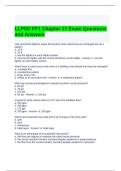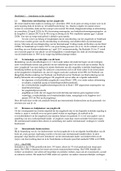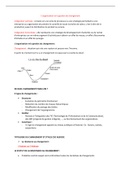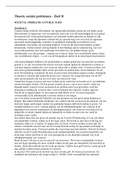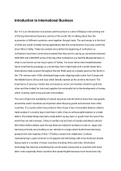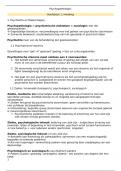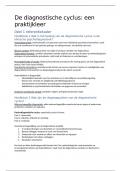LECTURE 1
Table of Contents
LECTURE 1 ........................................................................................................................3
World Politics: Interests, Interactions, Institutions (Frieden, Lake, Schultz) ................................ 3
The Origins, Development, and Possible Decline of the Modern State (Spruyt)........................... 9
Lecture 1: What is a state? What is sovereignty?.......................................................... 14
LECTURE 2 ......................................................................................................................19
United Nations, Security Council (Wood) ................................................................................ 19
Chapter 6: Realism (Dunne and Schmidt) ................................................................................ 23
Lecture 2: Realism ............................................................................................................. 29
LECTURE 3 ......................................................................................................................34
International Relations Theory: A New Introduction (Jørgensen) ............................................. 34
Global Governance and Developing Countries: The Implications of The Rise of China (Gu,
Humphrey & Messner) ........................................................................................................... 44
Lecture 3: Liberalism ......................................................................................................... 44
LECTURE 4 ......................................................................................................................51
Explaining regional integration (Mattli) ................................................................................... 51
Explorations: Latin America and the Caribbean: Between the OAS and CELAC (Segovia) ........... 57
Two steps forward? Assessing Latin American Regionalism Through CELAC (Kennedy & Beaton)
.............................................................................................................................................. 59
Lecture 4: Regionalism...................................................................................................... 61
LECTURE 5 ......................................................................................................................66
The Institutional Framework and Procedures (Lelieveldt & Princen) ........................................ 66
.............................................................................................................................................. 80
Political Parties and the European Parliament (Lelieveldt & Princen) ....................................... 80
Lecture 5: Institutional Framework of the EU ................................................................. 84
LECTURE 6 ......................................................................................................................88
Decision-making in the European Union (Lelieveldt & Princen) ................................................ 88
Economic and Monetary Union (Amy Verdun)......................................................................... 90
The Single Market: Deregulation, Regulation, and Integration (Young) .................................... 94
Policy-making under Economic and Monetary union (Hodsen) ................................................ 97
Negative and Positive integration (Scharpf)............................................................................. 97
Lecture 6: EU Economic Integration .............................................................................. 100
1
, LECTURE 1
LECTURE 7 .................................................................................................................... 104
The Area of Freedom, Security, and Justice (Uçarer) .............................................................. 104
Lecture 7: EU Political Integration ................................................................................. 110
LECTURE 8 .................................................................................................................... 114
The Political System of the EU (Hix & Hoyland) ...................................................................... 114
Majone's Perspective: ...........................................................................................................................115
Moravcsik's Perspective: .....................................................................................................................116
What is the matter with Europe? (De Vries) .......................................................................... 117
Lecture 8: EU Democratic Deficit and Eurosceptism .................................................. 122
2
, LECTURE 1
LECTURE 1
World Politics: Interests, Interactions, Institutions (Frieden, Lake, Schultz)
Understanding Interests, Interactions, and Institutions
INTERESTS – the fundamental building blocks of politics. Explanations of international
political events begin by specifying the relevant actors and their interests
COOPERATION – a type of interaction involving two or more actors working together to
achieve a preferred outcome. Successful cooperation depends on the number of interactions
among the actors, and the accuracy of the information they possess
BARGAINING – a type of interaction involving the distribution of a fixed value. That is, if
one actor gets “more,” someone else necessarily gets “less.” In bargaining, outcomes
depend on what will happen in the event that no agreement is reached. Actors derive power
from their ability to make the consequences of no agreement less attractive for the other
side.
INSTITUTIONS – set of rules. Actors comply with institutions because they facilitate
cooperation and lower the cost of joint decision-making in the pursuit of valued goals.
▪ Also restrain what actors can/cannot do, and thus they make some
outcomes more or less likely. Actors struggle over institutions in effort
to bias policy toward outcomes they prefer.
Interests: What Do Actors Want from Politics?
Interests
· What actors want to achieve through political action; their preferences over the
outcomes that might result from their political choices.
· Fundamental building blocks of any political analysis
· Determine how actors ran the desirability of different outcomes (most to least
preferred)
·
At the most general level, analysts group interests at the individual and collective
levels into 3 categories:
- Power or security
o All political actors require a degree of personal/collective security as a
prerequisite to all other goals
- Economic of material welfare
o Political actors desire a higher standard of living or quality of life (greater
income, more consumable goods, more leisure time)
o Not incompatible with the first if we think of economic welfare as the long-term
goal and security or power as a means to this end
3
, LECTURE 1
- Ideological goals
o Political actors may desire moral, religious, or other ideological goals,
(democracy, human equality, dignity, the glory of a particular god…)
o Ideas often play a key role in shaping what actors want/believe to be good
and desirable
o There is not a conflict between these interests and others
These three sets of general interests roughly divide the three schools of realism,
liberalism, and constructivism.
Agnostic approach – the authors do not assume that one set of interests is always
better in helping unravel puzzles of world politics.
Actors and Interests
Actors – basic unit for international politics analysis
o States (The US)
o Governments (the Bush administration)
o Groups within countries (Catholics)
o International organizations (The UNSC)
o Individuals (the ultimate political actors)
• Grouping individuals into larger categories with common interests is convenient
State – central authority with the ability to make and enforce laws, rules, and
decisions within a specified territory.
o has a prominence in international relations
• failed states – some states may experience a breakdown of central authority
Sovereignty – expectation that states have legal and political supremacy within their
territorial boundaries
o key part of the state’s definition
o involves control over policies, political processes, maintenance of domestic
order, and governance
States as Actors – Two Usages:
1. Security and power motivation
o States assumed to be motivated by a quest for security (safety from external
and internal threats) and power (means to ensure security) → NATIONAL
INTERESTS
o National interests – interests attributed to the state itself
2. Representation by national leaders
o States-as-actors used as a shorthand for national leaders acting on behalf of
their countries
o Actions in international politics often taken by individuals representing the
state (leaders, diplomats)
o No prior assumption about the origin of interests pursued by state agents
Dynamic Nature of Actors
- No fixed or permanent set of actors in IR
4
Table of Contents
LECTURE 1 ........................................................................................................................3
World Politics: Interests, Interactions, Institutions (Frieden, Lake, Schultz) ................................ 3
The Origins, Development, and Possible Decline of the Modern State (Spruyt)........................... 9
Lecture 1: What is a state? What is sovereignty?.......................................................... 14
LECTURE 2 ......................................................................................................................19
United Nations, Security Council (Wood) ................................................................................ 19
Chapter 6: Realism (Dunne and Schmidt) ................................................................................ 23
Lecture 2: Realism ............................................................................................................. 29
LECTURE 3 ......................................................................................................................34
International Relations Theory: A New Introduction (Jørgensen) ............................................. 34
Global Governance and Developing Countries: The Implications of The Rise of China (Gu,
Humphrey & Messner) ........................................................................................................... 44
Lecture 3: Liberalism ......................................................................................................... 44
LECTURE 4 ......................................................................................................................51
Explaining regional integration (Mattli) ................................................................................... 51
Explorations: Latin America and the Caribbean: Between the OAS and CELAC (Segovia) ........... 57
Two steps forward? Assessing Latin American Regionalism Through CELAC (Kennedy & Beaton)
.............................................................................................................................................. 59
Lecture 4: Regionalism...................................................................................................... 61
LECTURE 5 ......................................................................................................................66
The Institutional Framework and Procedures (Lelieveldt & Princen) ........................................ 66
.............................................................................................................................................. 80
Political Parties and the European Parliament (Lelieveldt & Princen) ....................................... 80
Lecture 5: Institutional Framework of the EU ................................................................. 84
LECTURE 6 ......................................................................................................................88
Decision-making in the European Union (Lelieveldt & Princen) ................................................ 88
Economic and Monetary Union (Amy Verdun)......................................................................... 90
The Single Market: Deregulation, Regulation, and Integration (Young) .................................... 94
Policy-making under Economic and Monetary union (Hodsen) ................................................ 97
Negative and Positive integration (Scharpf)............................................................................. 97
Lecture 6: EU Economic Integration .............................................................................. 100
1
, LECTURE 1
LECTURE 7 .................................................................................................................... 104
The Area of Freedom, Security, and Justice (Uçarer) .............................................................. 104
Lecture 7: EU Political Integration ................................................................................. 110
LECTURE 8 .................................................................................................................... 114
The Political System of the EU (Hix & Hoyland) ...................................................................... 114
Majone's Perspective: ...........................................................................................................................115
Moravcsik's Perspective: .....................................................................................................................116
What is the matter with Europe? (De Vries) .......................................................................... 117
Lecture 8: EU Democratic Deficit and Eurosceptism .................................................. 122
2
, LECTURE 1
LECTURE 1
World Politics: Interests, Interactions, Institutions (Frieden, Lake, Schultz)
Understanding Interests, Interactions, and Institutions
INTERESTS – the fundamental building blocks of politics. Explanations of international
political events begin by specifying the relevant actors and their interests
COOPERATION – a type of interaction involving two or more actors working together to
achieve a preferred outcome. Successful cooperation depends on the number of interactions
among the actors, and the accuracy of the information they possess
BARGAINING – a type of interaction involving the distribution of a fixed value. That is, if
one actor gets “more,” someone else necessarily gets “less.” In bargaining, outcomes
depend on what will happen in the event that no agreement is reached. Actors derive power
from their ability to make the consequences of no agreement less attractive for the other
side.
INSTITUTIONS – set of rules. Actors comply with institutions because they facilitate
cooperation and lower the cost of joint decision-making in the pursuit of valued goals.
▪ Also restrain what actors can/cannot do, and thus they make some
outcomes more or less likely. Actors struggle over institutions in effort
to bias policy toward outcomes they prefer.
Interests: What Do Actors Want from Politics?
Interests
· What actors want to achieve through political action; their preferences over the
outcomes that might result from their political choices.
· Fundamental building blocks of any political analysis
· Determine how actors ran the desirability of different outcomes (most to least
preferred)
·
At the most general level, analysts group interests at the individual and collective
levels into 3 categories:
- Power or security
o All political actors require a degree of personal/collective security as a
prerequisite to all other goals
- Economic of material welfare
o Political actors desire a higher standard of living or quality of life (greater
income, more consumable goods, more leisure time)
o Not incompatible with the first if we think of economic welfare as the long-term
goal and security or power as a means to this end
3
, LECTURE 1
- Ideological goals
o Political actors may desire moral, religious, or other ideological goals,
(democracy, human equality, dignity, the glory of a particular god…)
o Ideas often play a key role in shaping what actors want/believe to be good
and desirable
o There is not a conflict between these interests and others
These three sets of general interests roughly divide the three schools of realism,
liberalism, and constructivism.
Agnostic approach – the authors do not assume that one set of interests is always
better in helping unravel puzzles of world politics.
Actors and Interests
Actors – basic unit for international politics analysis
o States (The US)
o Governments (the Bush administration)
o Groups within countries (Catholics)
o International organizations (The UNSC)
o Individuals (the ultimate political actors)
• Grouping individuals into larger categories with common interests is convenient
State – central authority with the ability to make and enforce laws, rules, and
decisions within a specified territory.
o has a prominence in international relations
• failed states – some states may experience a breakdown of central authority
Sovereignty – expectation that states have legal and political supremacy within their
territorial boundaries
o key part of the state’s definition
o involves control over policies, political processes, maintenance of domestic
order, and governance
States as Actors – Two Usages:
1. Security and power motivation
o States assumed to be motivated by a quest for security (safety from external
and internal threats) and power (means to ensure security) → NATIONAL
INTERESTS
o National interests – interests attributed to the state itself
2. Representation by national leaders
o States-as-actors used as a shorthand for national leaders acting on behalf of
their countries
o Actions in international politics often taken by individuals representing the
state (leaders, diplomats)
o No prior assumption about the origin of interests pursued by state agents
Dynamic Nature of Actors
- No fixed or permanent set of actors in IR
4

